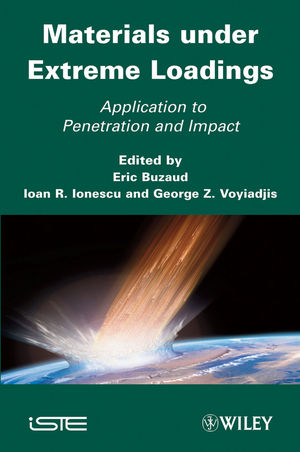Materials under Extreme Loadings: Application to Penetration and ImpactISBN: 978-1-84821-184-1
Hardcover
441 pages
March 2010, Wiley-ISTE
 |
||||||
Preface xv
Chapter 1. Geomaterials Under Extreme Loading: The Natural
Case 1
Philippe LAMBERT and Hervé TRUMEL
1.1. Introduction 1
1.2. Natural impacts 2
1.3. Discussion 27
1.4. Conclusions 32
1.5. Bibliography 33
PART 1. EXPERIMENTAL CHARACTERIZATION 45
Chapter 2. The Shock Properties of Concrete and Related
Materials 47
Kostas TSEMBELIS, David J. CHAPMAN, Christopher H. BRAITHWAITE,
John E. FIELD and William G. PROUD
2.1. Introduction 47
2.2. Experimental studies 53
2.3. Conclusion 65
2.4. Acknowledgments 65
2.5. Bibliography 66
Chapter 3. Comparison of Shocked Sapphire and Alumina
69
Geremy KLEISER, Lalit CHHABILDAS and William REINHART
3.1. Abstract 69
3.2. Introduction 70
3.3. Material 71
3.4. Experimental method 72
3.5. Experimental results 73
3.6. Conclusions 84
3.7. Acknowledgments 84
3.8. Bibliography 84
Chapter 4. Observations of Ballistic Impact Damage in Glass
Laminate 87
Stephan BLESS
4.1. Introduction 87
4.2. Transient measurements 88
4.3. Post-test measurements 90
4.4. Multiple impacts 97
4.5. Discussion and summary 97
4.6. Acknowledgments 98
4.7. Bibliography 98
Chapter 5. Experimental Analysis of Concrete Behavior Under
High Confinement 101
Xuan Hong VU, Yann MALECOT, Laurent DAUDEVILLE and Eric
BUZAUD
5.1. Introduction 101
5.2. Experimental device 102
5.3. Influence of the water/cement ratio 105
5.4. Influence of the coarse aggregate size 106
5.5. Influence of the cement paste volume 113
5.6. Conclusion and future work 116
5.7. Acknowledgment 118
5.8. Bibliography 118
Chapter 6. 3D Imaging and the Split Cylinder Fracture of
Cement-Based Composites 121
Eric LANDIS
6.1. Introduction 121
6.2. Methods and materials 122
6.3. Experiments and analysis 126
6.4. Experimental results 128
6.5. Conclusions 129
6.6. Bibliography 130
Chapter 7. Testing Conditions on Kolsky Bar 131
Weinong CHEN
7.1. Introduction 131
7.2. Kolsky bar 132
7.3. Limitations of the Kolsky bar 133
7.4. Methods for conducting valid Kolsky bar experiments 136
7.5. Conclusions 142
7.6. Bibliography 143
PART 2. MATERIAL MODELING 145
Chapter 8. Experimental Approach and Modeling of the Dynamic
Tensile Behavior of a Micro-Concrete 147
Pascal FORQUIN and Benjamin ERZAR
8.1. Introduction 147
8.2. Experimental device 149
8.3. Data processing 151
8.4. Experimental results 154
8.5. Modeling of the damage process in concrete at high strain-rates (the Denoual, Forquin, Hild model) 158
8.6. Conclusion 172
8.7. Bibliography 175
Chapter 9. Toward Physically-Based Explosive Modeling:
Meso-Scale Investigations 179
Hervé TRUMEL, Philippe LAMBERT, Guillaume VIVIER and Yves
SADOU
9.1. Introduction 179
9.2. Methodology 181
9.3. The material: microstructure and macroscopic mechanical behavior 182
9.4. Samples from unitary experiments 185
9.5. Analysis of a recovered target 193
9.6. Discussion 198
9.7. Conclusion and future work 204
9.8. Acknowledgments 204
9.9. Bibliography 204
Chapter 10. Coupled Viscoplastic Damage Model for
Hypervelocity Impact Induced Damage in Metals and Composites
209
George Z. VOYIADJIS
10.1. Introduction 209
10.2. Theoretical preliminaries for high velocity impact 212
10.3. A coupled rate-dependent (viscoplasticity) continuum damage theory 214
10.4. Computational aspects of the proposed theory 220
10.5. Numerical applications 228
10.6. Conclusions 240
10.7. Bibliography 241
Chapter 11. High-Pressure Behavior of Concrete: Experiments
and Elastic/Viscoplastic Modeling 247
Martin J. SCHMIDT, Oana CAZACU and Mark L. GREEN
11.1. Introduction 247
11.2. Experimental study 249
11.3. Elastic-viscoplastic model development 254
11.4. Conclusions 263
11.5. Bibliography 264
Chapter 12. The Virtual Penetration Laboratory: New
Developments 267
Mark D. ADLEY, Andreas O. FRANK, Kent T. DANIELSON, Stephen A.
AKERS, James L. O’DANIEL and Bruce PATTERSON
12.1. Introduction 267
12.2. Constitutive model development 268
12.3. Perforation simulations 278
12.4. Penetration simulations 282
12.5. CSPC penetration resistance equation 284
12.6. Conclusions 287
12.7. Acknowledgment 288
12.8. Bibliography 288
Chapter 13. Description of the Dynamic Fragmentation of Glass
with a Meso-Damage Model 291
Xavier BRAJER, François HILD and Stéphane ROUX
13.1. Introduction 291
13.2. Experimental results 292
13.3. Fragmentation analysis 294
13.4. Microcracking analysis 299
13.5. A “meso-damage” approach 302
13.6. Conclusion 306
13.7. Acknowledgments 307
13.8. Bibliography 307
PART 3. NUMERICAL SIMULATION TECHNIQUES 311
Chapter 14. An Approach to Generate Random Localizations in
Lagrangian Numerical Simulations 313
Jacques PETIT
14.1. Introduction 313
14.2. Numerical modeling 314
14.3. Electromagnetic compression and its regular use 318
14.4. Numerical simulations without rupture: copper and nickel samples 321
14.5. Numerical simulations with rupture: TA6V4 samples 323
14.6. Conclusion 328
14.7. Bibliography 330
Chapter 15. X-FEM for the Simulation of Dynamic Crack
Propagation 333
Alain COMBESCURE
15.1. Energy conservation when a crack propagates: a key issue 333
15.2. Dynamic crack propagation laws 339
15.3. Experiments interpretation 341
15.4. Bibliography 348
Chapter 16. DEM Model of a Rigid Missile Impact on a Thin
Concrete Slab 351
Frédéric DONZÉ, Wen-Jie SHIU and Laurent
DAUDEVILLE
16.1. Introduction 351
16.2. The DEM model 353
16.3. Modeling of the impact tests 355
16.4. Influence of reinforcement ratio 358
16.5. Influence of the nose shape of missile 361
16.6. Conclusion 365
16.7. Bibliography 365
Chapter 17. The Lattice Discrete Particle Model (LDPM) for
the Numerical Simulation of Concrete Behavior Subject to
Penetration 369
Gianluca CUSATIS
17.1. Introduction 369
17.2. Review of LDPM formulation 371
17.3. Uniaxial compression strength tests 375
17.4. Three-point bending tests 377
17.5. Multiaxial compression strength tests 378
17.6. Hopkinson bar tests 380
17.7. Penetration through reinforced concrete slabs 382
17.8. Closing remark 384
17.9. Acknowledgments 385
17.10. Bibliography 385
Chapter 18. An Improved Contact Algorithm for Multi-Material
Continuum Codes 389
Kenneth C. WALLS and David L. LITTLEFIELD
18.1. Introduction 389
18.2. Background 390
18.3. The contact-impact problem 391
18.4. Formulation 395
18.5. Finite element formulation 398
18.6. Calculations 401
18.7. Discussion 405
18.8. Conclusions 410
18.9. Bibliography 412
Chapter 19. Parallel Computing for Non-linear Concrete
Modeling 415
Kent DANIELSON, Mark ADLEY and James O’DANIEL
19.1. Introduction 415
19.2. Explicit dynamic finite element analysis 416
19.3. Numerical methodologies 417
19.4. Numerical applications 421
19.5. Concluding remarks 429
19.6. Acknowledgments 430
19.7. Bibliography 431
List of Authors 433
Index 439



